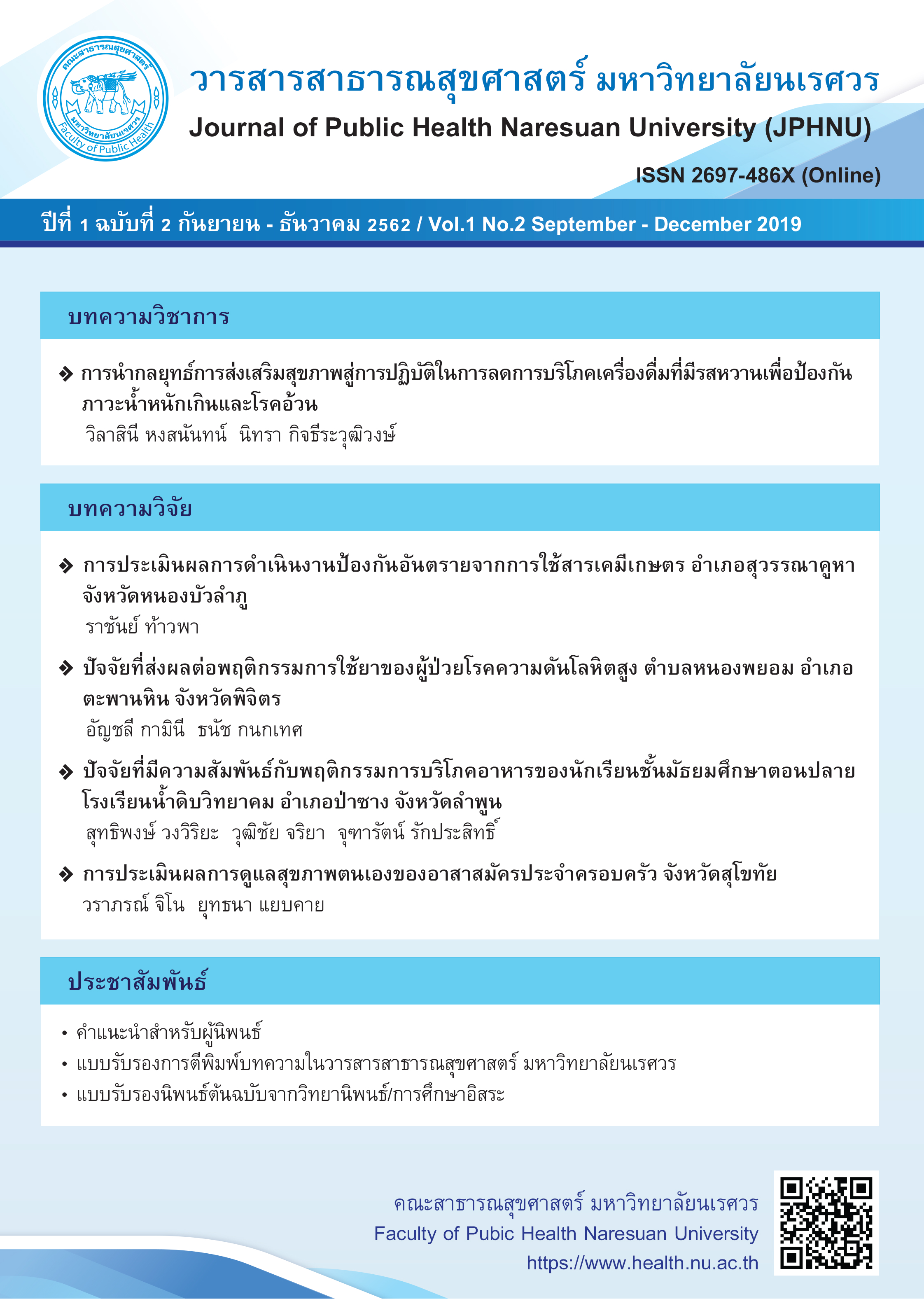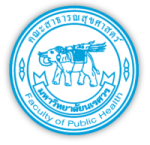Factors associated with food consumption behaviors among high school students in Namdibwittayakom School, Pasang District, Lamphun Province
Keywords:
Food consumption behaviors, High school students, PRECEDE-PROCEED modelAbstract
This survey research aimed to study the food consumption behaviors and to examine factors associated with food consumption behaviors among high school students in Namdibwittayakom Schools, Pasang District, Lamphun Province. The conceptual framework based on the PRECEDE-PROCEED model. The samples were 113 high school students. The data collected by using questionnaires divided into five sections; 1)general information, 2) knowledge of food consumption, 3) attitude of food consumption, 4) influence of media advertising on food consumption and 5) food consumption behaviors. The content validity scores of overall questionnaires were 0.67-1.00. The KR-20 reliability score of section 2 in questionnaires was 0.74. The Cronbach’s alpha reliability scores of sections 3-5 in questionnaires were 0.72-0.78. The data analyzed by using the Eta Coefficient and Pearson's Correlation Coefficient set the significance at level 0.05.
The results found that the food consumption behaviors of most of the sample (69.90%) were at a moderate level ( = 2.34-3.66). Factors statistically significant associated (p-value <0.05) with food consumption behaviors among sample were 1) the knowledge about food consumption (r = 0.186, p-value = 0.048), 2) the attitude on food consumption (r = 0.269, p-value = 0.004) and 3) the educational level of parents (F = 2.453, p-value = 0.001). Therefore, it is imperative to develop the knowledge and attitude towards food consumption in order to promote the appropriate food consumption behaviors among students.
References
Best, J. W. (1970). Research in Education. Englewood Cliffs, New Jersey: Printice-Hall.
Bloom, B. S. (1971). Handbook on formative and summative evaluation learning. New York: Megraw–Hill.
Choopayak, C. (2009). The Knowledge, Attitudes and Behaviors in Food Consumption of Upper-Secondary School Students at the Demonstration Schools under the Ministry of University Affairs in Bangkok Metropolis. Faculty of Education, Ramkhamhaeng University, Bangkok. (in Thai).
Green, L. W., & Kreuter, M. W. (2005). Health Program Planning an Educational and Ecological Approach. New York: Quebecor World Fairfield.
Mendonça, R. D. D., Pimenta, A. M., Gea, A., de la Fuente-Arrillaga, C., Martinez-Gonzalez, M. A., Lopes, A. C. S., & Bes-Rastrollo, M. (2016). Ultraprocessed food consumption and risk of overweight and obesity: The University of Navarra Follow-Up (SUN) cohort study. The American journal of clinical nutrition, 104(5), 1433-1440.
Ministry of Public Health. (2018). Percentage of normal weight and height rage among teenagers aged between 15-18 years old. Retrieved October 17, 2018, from https://hdcservice.moph.go.th/hdc/reports/report.php?source=pformated/format1.php&cat_id=46522b5bd1e06d24a5bd81917257a93c&id=9b019d9cc12576000e6e84acfb9ad7f0. (in Thai).
Ministry of Public Health. (2019). Percentage of normal weight and height rage among school-age students. Retrieved November 28, 2019, from https://hdcservice.moph.go.th/hdc/reports/report_kpi.php?flag_kpi_level=1&flag_kpi_year=2019&source=pformated/format1.php&id=e28682b2718e6cc82b8dbb3e00f2e28e. (in Thai).
Moohummud, S. (2001). Factors affecting food consuming of mathayomsuksa III students in school under the Department of General Education in Khet Dusit, Bangkok Metropolitan. Master of Education degree in Health Education, Graduate School, Srinakharinwirot University. (in Thai).
National Statistical Office. (2014). National Survey of Food Consumption Behaviors. Statistics Newsletter, 25(1), 7. (in Thai).
Nithitantiwat, P., & Udomsapaya, W. (2017). Food consumption behavior among Thai adolescents, impacts, and solutions. Journal of Phrapokklao Nursing College, 28(1), 122-128. (in Thai).
Ruangying, J. (2016). Food consumption behavior of adolescents in Songkhla Province: Synthesis of literacy and factors influencing food consumption behavior. Doctoral degree in Applied Behavioral Science Research, Srinakharinwirot University, Bangkok. (in Thai).
Wayne, W. D. (1995). Biostatistics: A Foundation of Analysis in the Health Sciences (6th ed.). New York-Chichester-Brisbane-Toronto-Singapore: John Wiley & Sons, Inc., 177-178.
Downloads
Published
How to Cite
Issue
Section
License
The published article is copyrighted by the Journal of Public Health and Health Sciences Research.
The statements that appear in each article in this academic and research journal are the personal opinions of each author and are not related to Naresuan University and other faculty members in the university. Responsibilities regarding each article are the responsibility of each author.






